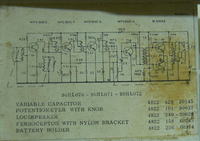Follow along with the video below to see how to install our site as a web app on your home screen.
Note: This feature may not be available in some browsers.



i meant superhetrodyneDid you mean Super regenerative receiver? This is a simple circuit, which is like a RF amplifier with a small amount of POSITIVE feedback applied to it. This has the effect of increasing the gain of the stage and increases its selectivity. The downside is it is difficult to make it stable and for maximum gain you need to twiddle the tuning capacitor and adjust another control called "reaction"
Frank







